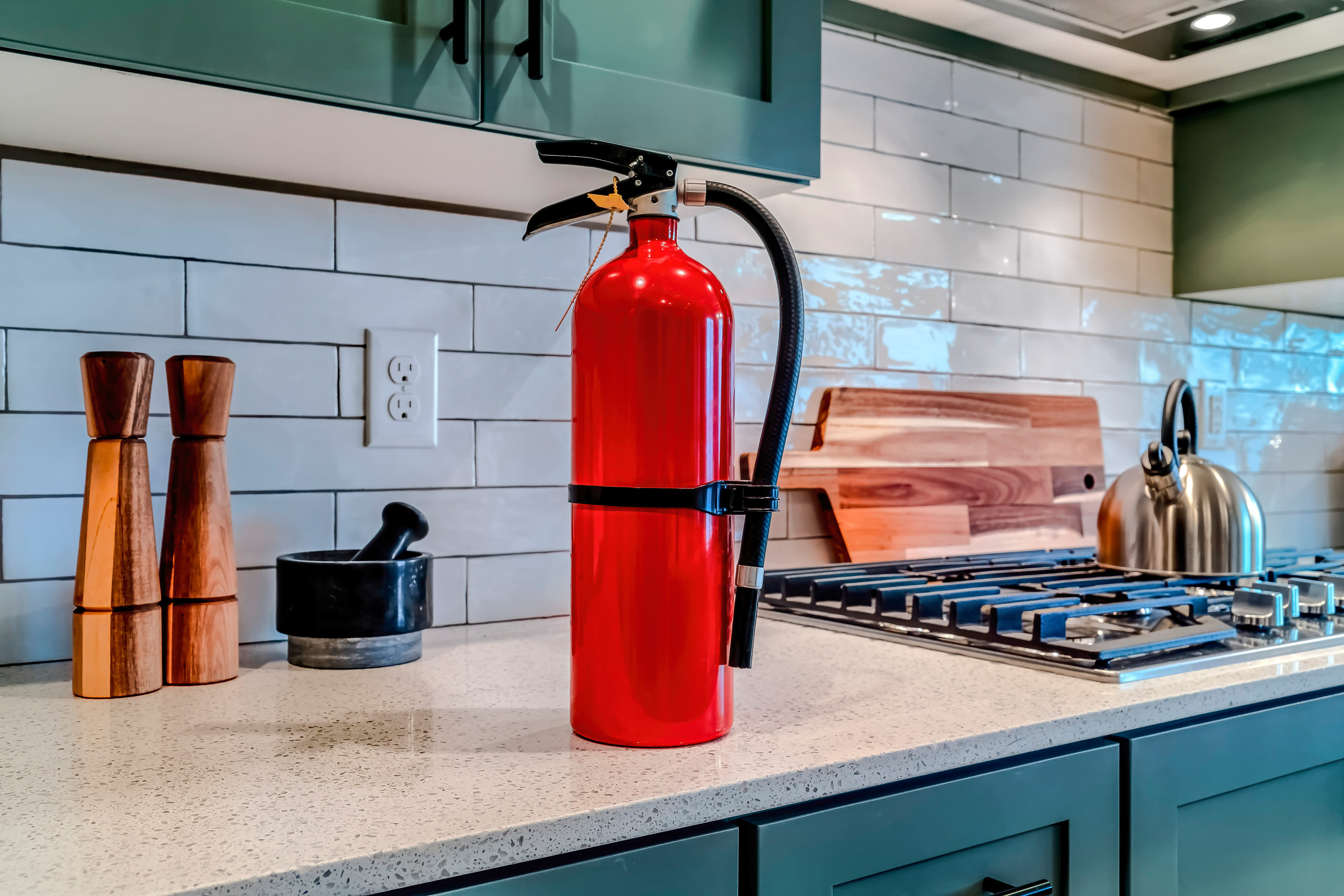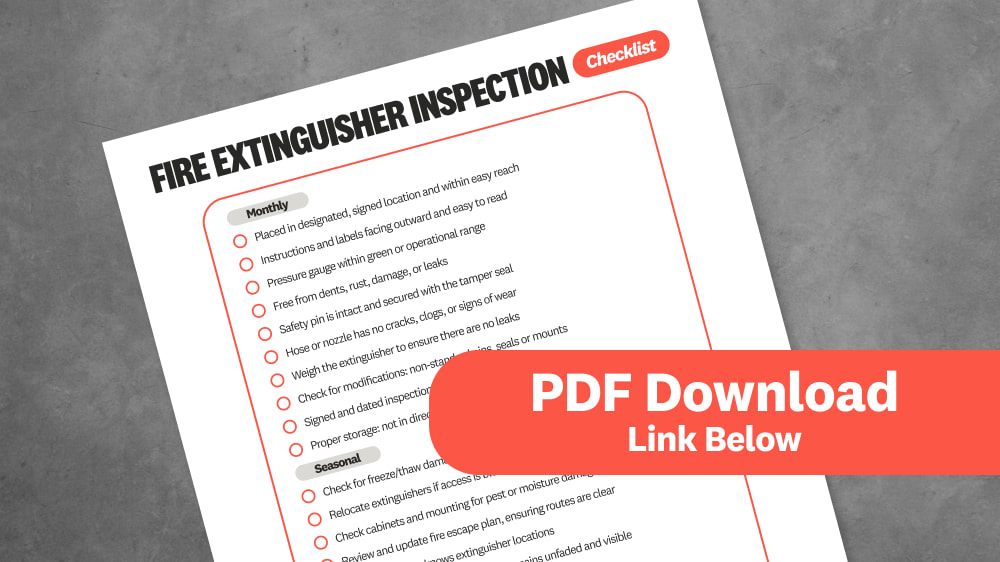
Drone roof inspection costs vary depending on the roof’s size, complexity, and material. Use this guide to budget for a drone roof inspection.
Extinguish this to-do list


A proper fire extinguisher inspection isn’t just a recommendation—it’s an annual requirement. Regular inspections are essential not just for your safety, but also to meet local, state, and federal fire codes. But when are fire extinguisher inspections required by the National Fire Protection Association (NFPA) and Occupational Safety and Health Administration (OSHA), and when is it simply advised?
That depends on whether the fire extinguishers are in a residential home or a business. But in either case, neglecting inspections could put lives and property at risk at the least, and result in hefty fines or insurance problems at most. Regular maintenance and documentation help keep fire extinguishers in good condition. Stay on top of these tasks to make sure your fire extinguisher is accessible, visible, and free from damage, leaks, or expired contents.
Having the right tools and supplies on hand makes inspections quicker and more effective for both homeowners and business owners. Whether you’re doing basic monthly checks or preparing for a professional annual inspection, here’s what to gather:
Inspection and maintenance tags
Tamper seals/safety pins
Flashlight
Protective gloves
Cleaning cloth
Marker or pen
Digital/physical inspection log
Owner’s manual for your extinguisher
Replacement parts (as needed)
Inspection and maintenance tags not only track history but may also be legally required for business compliance and insurance claims. Tamper seals and pins are crucial: a missing pin or broken seal may mean the extinguisher has been used or tampered with—replace them immediately. Gloves and a cleaning cloth ensure you can safely handle equipment and keep labels or operating instructions easy to read.

A monthly inspection catches issues missed in daily or weekly checks and is absolutely necessary for insurance coverage and compliance. Documenting each check is critical. If you identify any problem (e.g., undercharged, broken seals, blocked nozzle, faded labels), replace the extinguisher or call a professional for service right away.
Checking fire extinguishers on a monthly basis is required for all businesses, but is just a really good idea for homeowners as well. Anyone trained in fire extinguisher basics can perform monthly inspections. When you're done, document your findings on the inspection tag or log.
Monthly Inspection Checklist
The extinguisher is carefully placed in its designated, signed location where it's easy to reach.
The operating instructions and labels are facing outward, clean, and easy to read.
The pressure gauge is in the green or operational range, ensuring it's ready for use.
It’s in good condition, free from dents, rust, damage, or leaks.
The safety pin is present, intact, and secured with the tamper seal.
The hose or nozzle is securely attached, showing no cracks, clogs, or signs of wear.
A quick weight check, by lifting or weighing it, can help ensure there are no leaks—if it feels lighter than marked, it might need attention.
Make sure there are no unauthorized modifications, like non-standard pins, seals, or mounts.
The inspection tag should be signed, dated with your initials, and replaced when full. If there’s a cabinet, keep it unlocked or easily reachable without tools.
Proper storage is key—avoid placing it on the floor unless it’s meant for that, and keep it away from direct sunlight and moisture to ensure it stays in good shape.
Seasonal changes affect extinguisher reliability, particularly in outdoor, garage, or kitchen locations. Extreme temperatures can damage extinguisher seals and cause pressure loss. Adjustments to storage locations, outdoor access, or path clearing help ensure extinguishers are always usable—even if storms, holidays, or renovations change the building layout. This is also a good time to retrain family or staff on extinguisher use and evacuation procedures.
Complete these tasks at the beginning of each season or during routine cleaning:
Inspect for weather-related wear: look for freeze/thaw damage, rust, or water intrusion.
Relocate extinguishers if seasonal furniture, décor, or equipment will block access.
Check cabinets and mounting for pest or moisture damage.
Review and update your fire escape plan, ensuring routes are clear and everyone knows extinguisher locations.
Clean, dust, and ensure all signage remains unfaded and visible.
This task must be performed and certified by a licensed, professional fire protection company. Keep the certificate as evidence for regulators, inspectors, or insurers. Here’s what the pros will cover during their visit:
Complete disassembly and internal visual inspection of extinguisher components.
Test pressure and recharge or refill the extinguisher as needed.
Inspect and clean all moving and dispensing parts, including the hose, nozzle, valve, and handles.
Replace damaged or expired components such as pins, seals, labels, and chemicals.
Conduct a leak or hydrostatic test if due, which is typically required during 6- and 12-year intervals.
Affix, update, and certify the annual inspection tag.
Provide full documentation and a certificate of compliance for your records.
A fire extinguisher inspection costs $40 to $100 on average. This applies to more common units, like ABC dry chemical, water, and foam fire extinguishers. However, inspecting specialized units such as wet chemical fire extinguisher can cost up to $300.
In addition to fire extinguisher ratings, costs also rise with the number of extinguishers you need checked. Expect a flat fee of $5 to $15 for each additional fire extinguisher. Find a qualified home inspector near you for a specific quote. If you’re doing a full sweep of your home’s fire protection, a plumber is your best bet for sprinkler system installation and maintenance.
Annual inspections are required and must be performed by certified professionals. During the visit, the technician may also guide you on extinguisher placement and hazard coverage. Only a professional can legally certify the extinguisher for compliance. For units in businesses, industrial settings, and multi-family residences, failure to produce this certificate can result in fines, insurance issues, or business closure orders.
However, more frequent residential fire extinguisher checkups are simply encouraged and don’t require a trained hand. If you choose to take on seasonal or monthly inspections, most tasks can be performed with everyday items and the checklists above. But for annual and specialized maintenance, a pro or additional replacement parts may be needed.
From average costs to expert advice, get all the answers you need to get your job done.

Drone roof inspection costs vary depending on the roof’s size, complexity, and material. Use this guide to budget for a drone roof inspection.

If you’re buying a home, having an inspection offers reassurance that it’s in good condition. How much a home inspection costs varies depending on the home's size, age, condition, and location.

Home appraisals are an important part of buying or selling a home and getting a mortgage loan. Learn more about home appraisal costs and what they include.

Buying a home is expensive, so it can be tempting to cut costs wherever possible. Learn why a home inspection is worth it even though it adds to expenses.

Once you know the things that fail a home inspection, you can figure out a repair plan. Here are 15 common issues that can come up and how to address them.

Enjoy your view by ensuring the safety and longevity of your balcony. Use our balcony inspection checklist to monitor everything from railings to waterproofing.